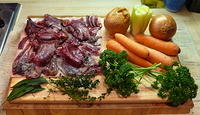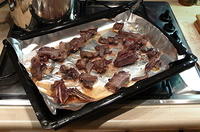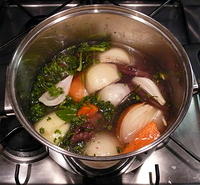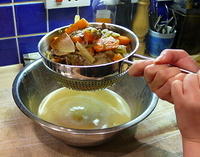Note: This entry has been restored from old archives.
Preamble, hare rama hare rama
This is my first harey recipe, and covers the making of a stock that’ll be used in two other harey recipes. It’s a pretty straightforward thing to do and a logical starting point. Unfortunately we’re busy cleaning the apartment this weekend as estate agents will be in on Monday to do an assessment and take photos… thus I may not get any other recipes out until next weekend. (We’ve decided that it is time to move into something that isn’t an apartment, and the owner has decided that it’s time to sell.)
Anyway, everyone should know how to make a stock and if you don’t you should learn! It really is rather trivial. These days you can get pretty good stock from the supermarket, and I mean the stuff in the fridge not the dreaded cubes (which I do use from time to time and I always have a few kicking around in the cupboard.) However, I do think you can make a better stock. It’s not just about better though, it’s about making optimal use of your food. Bones the butcher would otherwise throw out (these days), leftover roast chicken, whatever’s about really. Making stock is a skill worth learning and it’ll serve you well in the dark days ahead.
Of course this isn’t going to be a very typical stock, but you can look at the recipe below as a template. For example, you could replace the hare parts with a broken up roast chicken carcass and some chicken wings (from some good free-range birds!) The stock described here comes out pretty strong and quite gamey… good for recipes involving the rest of the hare but probably not much good for other cooking.
Input

I’m going to be a bit rough with the ingredients list here, precision isn’t necessary. The photo on the right really gives all the information you need, I could probably leave the list below out! Please use happy vegetables for happy flavours… save the bendy carrots for some chooks, local horses, or something. (And don’t buy so many that you let them get into that state next time… happens to me all the time, not having much livestock nearby I eat them raw before they can get too bad.) The ingredients can be multiplied by as many times as you’d like to make more stock, it’s great for freezing (and you can reduce it first to use less freezer space.) I don’t recommend trying to make it in a lesser quantity though, this is as small as I’d go for making a stock.
- 550g
- hare forelegs and offcuts
- drizzle
- light olive oil
- 3 medium
- carrots
- 2 medium
- onions
- 3 sticks
- celery
- 3
- fresh bayleaves
- 6 sprigs
- fresh thyme
- handful
- fresh parsley
Algorithm

First, preheat your oven to 220C. Ensure hare bits are clean, pat dry if wet, and toss with some oil in a bowl. Spread the bits around a baking tray and place in the hot oven for a 15 minute sizzle. Meanwhile peel the carrots (or don’t if they look pretty good) and chop them into about 3 or 4 pieces. Then quarter the onions, and cut the celery into 2 inch lengths.

After the hare bits have sizzled for 15 minutes remove from the oven and place the hare and all juices and scrapings from the pan into a smaller sized stock pot (22cm in my case.) Throw in the herbs and then pack in the vegetables, pack everything down as tightly as you can. The idea is that you want as little liquid as possible. Flush any remaining bits and oil from the hare roasting pan into the stock pot with about 500ml of water. Then top up the with just enough water to barely cover the content (note that the veggies may float a little, be careful not to add too much water.) In the end I added about 1.5l (photo left.)

Bring the pot to a gentle simmer, then place it on the smallest flame your stove can do. If, even then, it simmers any more than lethargically you might want to, assuming you have a gas stove, get yourself a simmer mat/ring for future simmering occasions (a fallback option, if you use an oven-proof pot, is to put it in a 120C oven after getting it to simmering point on the stove.) Now you can just leave it alone for about 3 hours, though you might want to give it a good stir every hour or so (I did, but it probably doesn’t matter.)
When the simmering time is up take the pot off the heat and give it a good 30-minutes to full-hour to cool down. When cool enough to handle strain the stock through a large-hole sieve or colander. Give it a good pressing to get out as much fluid as you can without pressing mashed vegetable through the holes in your strainer. Now strain back into the rinsed stock pot through a fine sieve (if you’re after a clearer stock you could do another step straining through wetted muslin, more about that some other time maybe.) Put the strained stock back onto the stove and re-heat/reduce as required for your purposes. I got about 1 litre of stock out of this which I then reduced down to 500ml of fairly rich stock. Alternatively, refrigerate or freeze the stock for some future cooking endeavour!